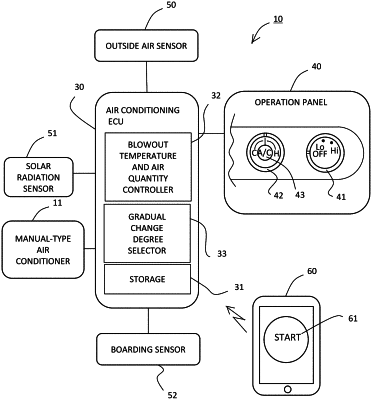| CPC B60H 1/00657 (2013.01) [B60H 1/004 (2013.01); B60H 1/00742 (2013.01); B60H 1/00778 (2013.01); B60H 1/2218 (2013.01); B60H 1/24 (2013.01); B60H 1/32 (2013.01); B60H 2001/2234 (2013.01)] | 2 Claims |

|
1. A control system of an air conditioner for a vehicle, the control system comprising:
an air conditioner configured to receive instructions remotely or manually, in which a blowout temperature and an air quantity of an air-conditioning air from a blowout outlet are manually adjusted by an operation of a user interface in a vehicle cabin by a user; and
a processor that is configured to cause the air conditioner to execute remote air conditioning in response to a command from outside of the vehicle in a state in which the user is not boarding the vehicle, wherein
the processor is configured to
start actuation of the air conditioner with (i) a maximum temperature which is a maximum highest temperature capacity of the control system during a heating operation or a maximum lowest temperature capacity of the system during a cooling operation as a target blowout temperature of the air-conditioning air and (ii) a maximum air quantity as a target air quantity of the air-conditioning air in response to a trigger command of the remote air conditioning,
gradually change and reduce the target air quantity while gradually changing the target blowout temperature toward a target intermediate temperature with elapse of time, the target intermediate temperature being a predetermined temperature lower than the maximum highest temperature capacity of the control system during the heating operation and higher than the maximum lowest temperature capacity of the system during the cooling operation, and
change the target blowout temperature and the target air quantity respectively to a set blowout temperature and a set air quantity at a time of previous disembarkment, when boarding of the user to the vehicle is detected.
|